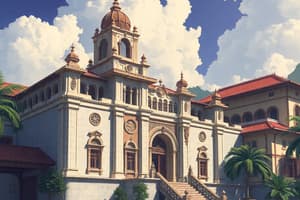Podcast
Questions and Answers
Which period in Philippine history directly followed the Spanish Colonial Period?
Which period in Philippine history directly followed the Spanish Colonial Period?
- Prehistoric Period
- Precolonial Period
- American Colonial Period (correct)
- Post Independence
What is the significance of Simbang Gabi in Filipino culture?
What is the significance of Simbang Gabi in Filipino culture?
- It is a festival dedicated to harvest.
- It celebrates the New Year.
- It honors the ancestors of the Filipino people.
- It is a series of nine dawn masses leading up to Christmas. (correct)
Which of the following groups is NOT mentioned as a historical influence in the Philippines?
Which of the following groups is NOT mentioned as a historical influence in the Philippines?
- Austroasiatics
- South Asians
- Native Americans (correct)
- Negrito
Which characteristic is associated with the architecture of the Philippines?
Which characteristic is associated with the architecture of the Philippines?
Which language was declared the official language during the First Philippine Republic?
Which language was declared the official language during the First Philippine Republic?
What aspect of Filipino culture does the term 'Bayanihan' refer to?
What aspect of Filipino culture does the term 'Bayanihan' refer to?
What is the significance of the Metropolitan Theater in Philippine mythology and folklore?
What is the significance of the Metropolitan Theater in Philippine mythology and folklore?
How many languages are estimated to be spoken in the Philippines?
How many languages are estimated to be spoken in the Philippines?
Flashcards are hidden until you start studying
Study Notes
Introduction to Philippine Architecture
- Architecture in the Philippines is diverse, reflecting cultural, historical, and geographical influences.
- The Philippines was a hub for cultural exchange due to its geographical location, resulting in various architectural expressions and regional variations.
Culture
- Bayanihan: Represents the spirit of community and cooperation, evident in Filipino culture.
- Filipino Extended Family: Emphasizes strong family ties and interconnectedness.
History
- Prehistoric Period (pre-900): Marked by the presence of indigenous groups, including the Negrito, Austroasiatics, Papuans, South Asians, and Austronesians.
- Precolonial Period (900-1565): This period saw the emergence of early Filipino civilizations with unique cultural and architectural practices.
- Spanish Colonial Period (1565-1898): Spanish influence heavily impacted the Philippines, introducing architectural styles like Baroque, Gothic, and Renaissance.
- American Colonial Period (1898-1946): The American presence brought about modernist and functionalist architectural styles.
- Post Independence (1946-1965): This period saw the Philippines embrace a more independent architectural identity, drawing from its rich cultural heritage.
- Marcos Era (1965-1986): Characterized by grand infrastructure projects and a focus on modernism.
- Contemporary Period (1986-present): This era encompasses a diverse range of architectural styles, often integrating traditional elements with contemporary approaches.
Languages
- The Philippines boasts 130-195 languages.
- Spanish served as the official language during the First Philippine Republic.
- The Philippine Revolution in 1899 led to the drafting of the Malolos Constitution, where Spanish was the primary language.
- English became the primary language of instruction in 1901.
- Tagalog became the standardized Filipino language, alongside English.
Traditions
- Love for Lechon: A popular dish in Filipino cuisine, representing cultural celebrations and festivities.
- Undying Faith: Christianity plays a significant role in Filipino culture, influencing many aspects of life.
- Hospitality: Filipinos are known for their warm welcoming nature and friendly approach to guests.
- Festivals during Fiestas: Colorful and vibrant celebrations are common throughout the year.
Mythology and Folklore
- Oral Literature: Storytelling traditions are prevalent in Filipino culture, passed down through generations.
- Written Literature: Literary works of Filipinos have evolved over time and continue to represent their cultural identity.
- The Metropolitan Theater: A significant landmark in Manila, representing Filipino architectural heritage and cultural significance.
Religion
- The Philippines is the only Christian nation in Asia, with Catholicism having a significant influence on its culture and architecture (church architecture).
- Church architecture plays a prominent role in the Philippine landscape, showcasing a combination of Spanish colonial influences and indigenous elements.
- Numerous churches in the Philippines have been designated as World Heritage Sites.
Studying That Suits You
Use AI to generate personalized quizzes and flashcards to suit your learning preferences.




